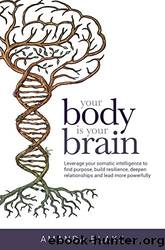Your Body Is Your Brain_Leverage Your Somatic Intelligence to Find Purpose, Build Resilience, Deepen Relationships and Lead More Powerfully by Amanda Blake

Author:Amanda Blake [Blake, Amanda]
Language: eng
Format: epub
ISBN: 9780999368107
Amazon: B07DHD99YB
Publisher: Trokay Press
Published: 2018-06-07T00:00:00+00:00
* * *
Taking a deep breath may calm you, but typically that only works when the situation is relatively low-stakes, familiar, and more or less under your control. Nicholeâs days were so demanding and action-packed that the proverbial âdeep breath and count to tenâ barely registered. When the stakes get higher, you need more powerful tools.
In the last chapter we saw that how you stand impacts courage: The psoas muscles that control pelvic tilt also affect your capacity to relax and stay calm, cool, and collected. Because these muscles attach on the same vertebra as the diaphragm, they also affect how you breathe. And the muscles you use to breathe are the same muscles you use to stay upright. With every breath, you subtly challenge your balance and postural stability.
It may surprise you to learn that in addition to your respiratory diaphragm, your pelvic floor and thoracic inlet also play a role in both breathing and structural stability. In other words, you have not one diaphragm, but three. And they all act in unison to fill the body with breath. Watch a baby breathe and youâll see the belly rhythmically rise and fall. Infants breathe using their whole torso.
According to research by Massery, Hagins, and Hodges, these three diaphragms function like interlocking gears.7 They contract automatically to stabilize the body during movement, which means how you move can affect how you breathe, either to your benefit or to your detriment. Dysfunction in one diaphragm affects each of the others, creating a loss of function and power in the extremities, spine, andâgermane to our purposes hereârespiration.8 This can affect not only mood, but also cognition, digestion, sleep, pain, and more.
Physical therapist Matthew Taylor has pointed out that such dysfunction can arise not only through physical injury, but also through the slings and arrows of everyday life: spiritless work, long-held resentments, marriage troubles, orâas in Nicholeâs caseâchronic stress.9 Tough situations such as these can cause chronic muscular contraction that can affect any muscle in the body, including the psoas and any of the three diaphragms. See if you can sense the muscles involved in âbiting your tongue,â for instance, or âbeing a tightass.â Metaphors like these are often less metaphorical and quite a bit more literal than we typically realize.
By the time weâre adults, most of usâboth men and womenâhave been âsucking it inâ for years, in a decades-long attempt to meet societyâs flat-bellied standards of beauty. Unless you pause to consciously make it so, you probably no longer engage your entire torso on a breath-by-breath basis. Unconsciously breathing from the neck and upper chest places an ongoing burden on your body, subtly activating the sympathetic branch of the nervous system and keeping you in a perpetual state of low-level fight or flight. Because shallow breathing is associated with emotions such as fear and surprise, this habitual breath pattern propagates a persistent message of mild anxiety throughout your entire system.
You breathe at least nine hundred times an hour.
Download
This site does not store any files on its server. We only index and link to content provided by other sites. Please contact the content providers to delete copyright contents if any and email us, we'll remove relevant links or contents immediately.
Periodization Training for Sports by Tudor Bompa(8170)
Why We Sleep: Unlocking the Power of Sleep and Dreams by Matthew Walker(6618)
Paper Towns by Green John(5091)
The Immortal Life of Henrietta Lacks by Rebecca Skloot(4525)
The Sports Rules Book by Human Kinetics(4294)
Dynamic Alignment Through Imagery by Eric Franklin(4118)
ACSM's Complete Guide to Fitness & Health by ACSM(3989)
Kaplan MCAT Organic Chemistry Review: Created for MCAT 2015 (Kaplan Test Prep) by Kaplan(3940)
Introduction to Kinesiology by Shirl J. Hoffman(3726)
Livewired by David Eagleman(3684)
The Death of the Heart by Elizabeth Bowen(3552)
The River of Consciousness by Oliver Sacks(3541)
Alchemy and Alchemists by C. J. S. Thompson(3451)
Bad Pharma by Ben Goldacre(3357)
Descartes' Error by Antonio Damasio(3230)
The Emperor of All Maladies: A Biography of Cancer by Siddhartha Mukherjee(3066)
The Gene: An Intimate History by Siddhartha Mukherjee(3047)
The Fate of Rome: Climate, Disease, and the End of an Empire (The Princeton History of the Ancient World) by Kyle Harper(3003)
Kaplan MCAT Behavioral Sciences Review: Created for MCAT 2015 (Kaplan Test Prep) by Kaplan(2940)
